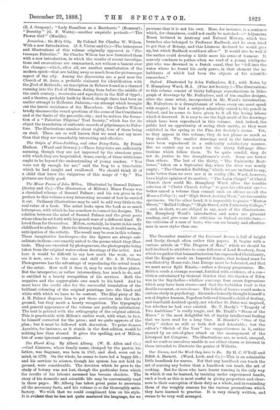Twelve Etchings Contributed to the " Portfolio" by Paul Adolphe
Bajon. With a Brief Memoir and Notes. By F. G. Stephens. (Seeley and Co.)—M. Rajon died, in the prime of his powers, last June, of an attack of pleurisy contracted at the burial of a friend. He was, by common acknowledgment, one of the best etchers of a time in which the art has received an extraordinary impulse. Born at Dijon, he came to seek his fortune in Paris in his twenty-first year. His first employment was touching-up photographs ; his second, that of producing cartoons for painters of stained glass. All along his ambition was to become a painter in oils. To the last he never abandoned it; and though he never attained success with the brush, yet, as Mr. Stephens points out, his practice with it gave him a sympathy which was of incalculable value in the rendering of the work of great painters. It was in 1865 that he began to etch, under the instruction of M. Leon Gaucheret. His first work, "Rembrandt dans son Atelier," was an astonishing success. Thenceforward his career was assured. With the interruption of 1870, when he served during the siege of Paris in the "Enfants perdus de la Villette," a rifle corps which was in a large measure made up of artists, he worked diligently at his calling. In 1872, he paid his first visit to this country, repeating it every following year. Here he soon became well known, though it is amusing to read that in early days a London publisher (of prints) refused to give more than £40 for an etching of Mr. Watts's portrait of John Stuart Mill. M. Rajon pub- lished it himself, received more than .2600 in less than three months, and realised an annual income from it ever after ! The twelve etchings reproduced in this volume are "Portrait of Gevartius," after Van Dyck, an admirable work, which has been rightly chosen for a frontispiece ; "Philip IV. of Spain," after Velasquez ; • "A Lady and Child," probably Mrs. Masters (after Sir Joshua Reynolds) ; "The Fighting Temeraire,' " "The Dutch Housewife (N. Mess); "A Knight in Armour" (Giorgione) ; Gerard Dow's portrait of himself—Rajon was especially successful in his portraits—" Prayer" (G. Paul Chalmers); "St. George"
(E. J. Gregory) ; "Lady Hamilton as a Bacchante" (Romney) ; " Dorothy " (G. F. Watts)—another exquisite portrait—" The Flower Girl" (Murillo).











































 Previous page
Previous page